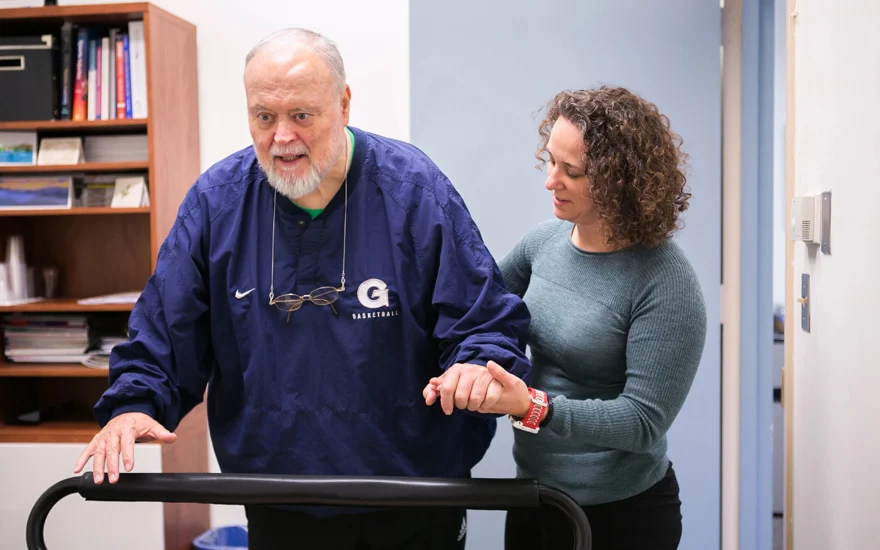Walking is an activity that many of us take for granted, but when something goes awry with our ability to move properly, it can have a significant impact on daily life. Gait dysfunctions, or problems with walking, are relatively common, especially as people age, and they are often a primary cause of falls among older adults. However, with the right diagnosis and treatment, most gait dysfunctions can be managed or improved. In this guide, we’ll explore what gait dysfunctions are, how physical therapists diagnose and treat them, and how you can prevent or minimize their effects.
What Are Gait Dysfunctions?
A gait dysfunction occurs when the pattern of walking is altered. Walking may become more laborious, and other areas of the body may experience added stress. Changes in gait can be a sign of underlying health problems, including:
- Inner ear disorders affecting balance
- Neurological conditions like Parkinson’s disease
- Muscle diseases such as muscular dystrophy
- Joint, bone, or muscle injuries
Common types of gait dysfunction include:
- Antalgic Gait: Often resulting from pain, particularly in the leg, this gait is characterized by a limp. The individual will take short, slow steps to avoid bearing weight on the painful leg.
- Ataxic Gait: People with this gait often have an unsteady, erratic walking pattern, with inconsistent foot placement. A wide stance is typically adopted for balance. Conditions such as multiple sclerosis, certain strokes, and cerebellum disorders can cause this type of gait.
- Parkinsonian Gait: Associated with Parkinson’s disease, this dysfunction causes individuals to shuffle their feet in short, slow steps. There may also be difficulty starting or stopping walking.
- Steppage Gait: This occurs when a person has “foot drop” – an inability to lift the foot from the ankle. The person compensates by lifting their leg higher than usual, often resulting in a “slapping” sound as the foot hits the ground. Conditions like neuropathy or stroke can lead to this gait.
- Vestibular Unsteadiness: Often caused by inner ear disorders like vertigo or Meniere’s disease, this gait is characterized by unsteady walking and a tendency to fall toward one side.
- Waddling Gait: People with muscular diseases or marked weakness in the hip and thigh muscles may experience a waddling gait, where they sway side to side and often walk on their toes.
- Slow Gait: A slower walking pace, often due to aging or fear of falling, can result in a general decline in mobility.
If you notice any of these changes in your walking pattern, it’s important to consult with a healthcare provider, particularly a physical therapist, who can help determine the cause and develop an appropriate treatment plan.
How Are Gait Dysfunctions Diagnosed?
The process of diagnosing a gait dysfunction begins with a detailed assessment by a physical therapist. These professionals are movement specialists trained to evaluate the mechanics of your walking and identify the root causes of your symptoms.
During the evaluation, your physical therapist will ask questions to understand the onset and progression of your condition:
- When did you first notice the change in your walking pattern?
- Has it worsened over time?
- Are you experiencing pain while walking?
- Have any recent medical issues, such as new medications or illnesses, contributed to the problem?
Your therapist will also observe your walking pattern and may perform several tests, including:
- Gait speed measurements: To assess how quickly you walk and whether your speed is affected.
- Balance tests: To determine how stable you are while walking.
- Strength and range-of-motion tests: To assess whether muscle, bone, or joint issues are affecting your gait.
- Sensation and reflex checks: To see if nerve damage is contributing to the dysfunction.
- Heart rate and blood pressure monitoring: To evaluate how walking impacts your cardiovascular system.
Based on these assessments, your physical therapist will be able to pinpoint the type of gait dysfunction and recommend the most appropriate treatment plan.
How Can a Physical Therapist Help?
Physical therapists are key to addressing and treating gait dysfunctions. They create personalized rehabilitation programs to help restore normal walking patterns, improve mobility, and reduce the risk of falls. Here are some common strategies physical therapists use to help patients with gait problems:
- Pre-Gait Training: Before focusing on walking itself, your therapist may begin with exercises to help you develop the necessary muscle strength and coordination. This can involve shifting your weight between legs, performing stepping motions, or simply standing in place to build stability.
- Gait Training: The core of physical therapy for gait dysfunction involves retraining your walking pattern. Depending on the cause of the dysfunction, your therapist will develop specific exercises to address your needs. This might include techniques for improving foot placement, rhythm, and posture while walking.
- Balance and Coordination Exercises: To prevent falls and improve stability, your therapist may incorporate balance exercises into your routine. These can include standing on one leg, walking heel-to-toe, or using specialized equipment like balance boards.
- Neuromuscular Reeducation: This technique focuses on reactivating and retraining muscles that may have become weak or uncoordinated. Your therapist may use electrical stimulation or specific exercises to improve the timing and coordination of your muscles during walking.
- Bracing or Splinting: In cases of severe weakness or paralysis, a therapist may recommend using braces or splints to support your joints and help you move more effectively. These devices can help you maintain a functional gait while addressing underlying muscle weakness.
Can Gait Dysfunction Be Prevented?
While some gait dysfunctions, particularly those linked to genetic factors or neurological conditions, may not be fully preventable, there are ways to reduce the risk or slow their progression:
- Stay active: Regular exercise, particularly strength training and balance exercises, can help keep muscles and joints strong, reducing the likelihood of gait problems.
- Address pain early: If you experience any discomfort while walking, it’s important to seek treatment early to prevent the development of compensatory walking patterns that can lead to dysfunction.
- Monitor your health: Managing chronic conditions like diabetes, arthritis, and neurological disorders can help prevent gait-related complications.
What Kind of Physical Therapist Do You Need?
Most physical therapists are trained to handle gait dysfunctions, but for specialized care, consider seeking a therapist with expertise in geriatric, neurological, or orthopedic rehabilitation. If your gait dysfunction is linked to a specific medical condition, such as a neurological disorder, a therapist with advanced training in that area may be particularly helpful.
When choosing a physical therapist, ask about their experience with gait problems and feel free to seek recommendations from your healthcare provider or community. The right therapist will help you restore your walking pattern, improve your quality of life, and reduce your risk of falls.
Conclusion
Gait dysfunctions can affect anyone, but with early diagnosis and the right treatment, most people can significantly improve their walking ability. Physical therapists play a vital role in helping individuals regain their mobility, reduce pain, and prevent further complications. If you or a loved one is experiencing changes in walking, don’t hesitate to seek the expertise of a physical therapist. With the right care, you can take strides toward better health and greater independence.



